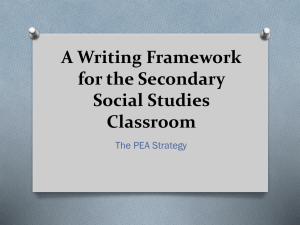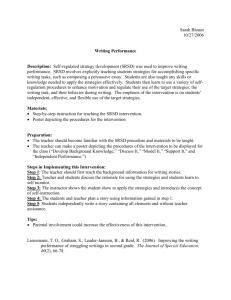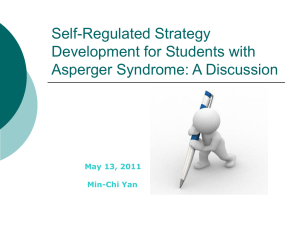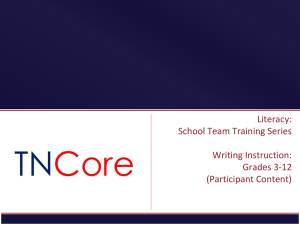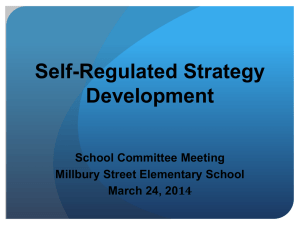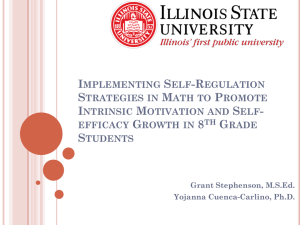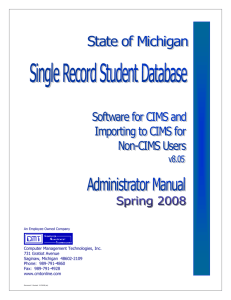Module 1: Focusing Memo - Gmu
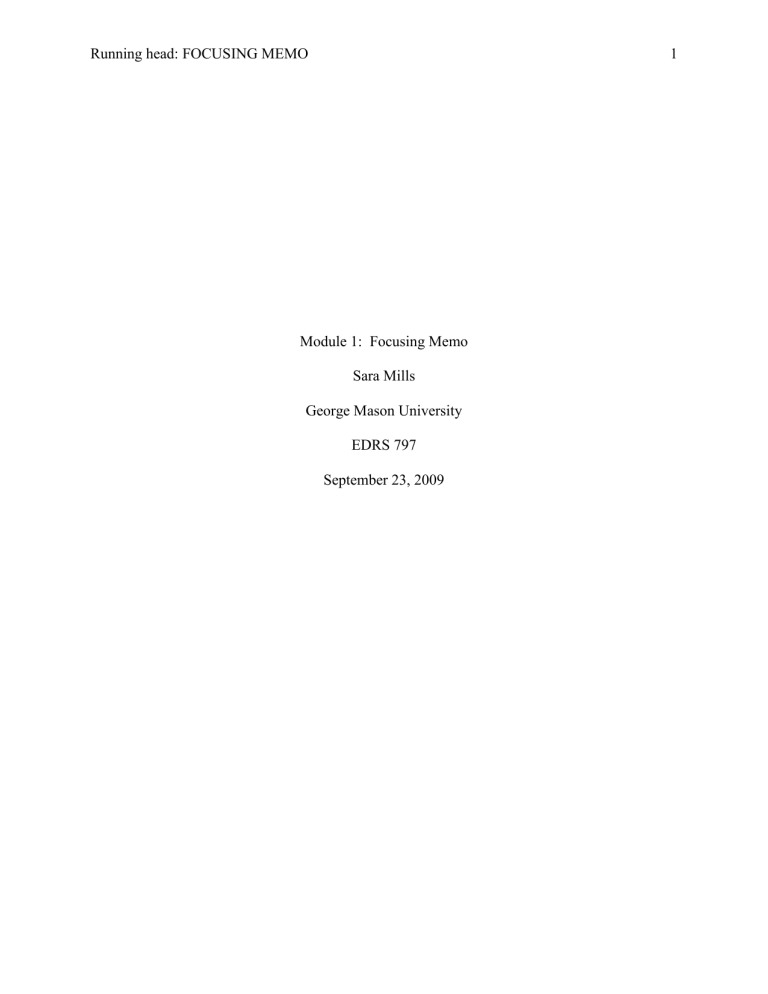
Running head: FOCUSING MEMO
Module 1: Focusing Memo
Sara Mills
George Mason University
EDRS 797
September 23, 2009
1
Running head: FOCUSING MEMO 2
Module 1: Focusing Memo
My research interest revolves around implementing research-based instructional practices in real-world classroom settings. In the field of special education, quantitative research has identified many instructional strategies that improve the learning of students with disabilities.
However, much of this research has been conducted in settings that do not match classroom conditions. For example, in the area of writing, more than 20 years of research has shown selfregulated strategy development (SRSD) to be a highly effective strategy for teaching students with learning disabilities how to write both narrative and expository essays. No other writing strategy has the amount of research, the quality of research, or the high level of results of SRSD.
Unfortunately, nearly all of the SRSD studies have been conducted with small groups of students and have relied on researchers to implement the intervention (Graham, 2006). The majority of students with learning disabilities in grades k-12 receive language arts instruction in the general education classroom (Newman, 2006). A research environment that uses small groups of students taught by researchers does not mimic the classroom demands that students with disabilities encounter every day in schools.
This gap between what is done in research and what is required in schools is a point of interest in the field of special education. The US Department of Education’s Office of Special
Education Programs (OSEP) includes a research-to-practice division whose sole purpose is to get information about research-based practices into the hands of teachers. Yet, the gap between research and practice persists, with both sides blaming the other. I have heard researchers comment that teachers do not implement interventions correctly. I have also heard teachers say that they do not find reading research studies helpful; they find more value in talking to other
Running head: FOCUSING MEMO 3 teachers about instructional issues. When it comes to figuring out how to best teach students with disabilities, I believe both sides have a lot to offer.
As I transition from being a teacher to being a researcher, I am continually aware that teachers have an incredible amount of knowledge about how to teach their students that is not customarily tapped by researchers implementing an intervention. If anything, researchers try to keep a tight rein on teachers’ practices so that the study can be tightly controlled to meet the methodological demands of quantitative research. I believe that by using the knowledge of classroom practice that teachers bring to the table, researchers can refine and adapt their research-based best practices to make them more amenable to classroom implementation.
In my study, then, I would like to take research-based instructional practices and put them in the hands of teachers to see how the strategies need to be adapted and tweaked to be effective in day-to-day classroom environments. Additionally, I would like to know how the adapting and tweaking affects student performance, and how that performance compares to results achieved in research-based settings. This is the step that I see is missing in many lines of research. Learning this type of information about how interventions are actually used in the classroom benefits researchers and teachers. Not only will it help to make the interventions, themselves, more classroom-friendly, but it will also give researchers a process for transitioning their researchbased practices into use in schools.
As a graduate research assistant, I have had the opportunity to work on three SRSD research studies. I am very interested in writing for students with learning disabilities because I think this is an area that many teachers struggle to teach well, and it is an area in need of more research. Therefore, my specific interest for this study is to implement SRSD in a classroom setting, using classroom teachers as the interveners. Instead of simply giving teachers the lesson
Running head: FOCUSING MEMO 4 protocols to follow and tightly controlling their instruction, I would like to work with teachers to adapt SRSD to the classroom environment and classroom demands.
There are several things I would like to learn by doing this study. First, I would like to know what teachers find unworkable about an intervention, what gaps they see in the instructional approach, and how they would remedy these issues. Second, I would like to see how teachers’ in-the-moment instruction aligns with or deviates from the SRSD lesson plans.
This could point to gaps in the SRSD lessons or it could illuminate strategies that teachers find work so well with their students that the teachers are not willing to give them up for the new strategy. Third, I would like to know how teachers feel about the SRSD lessons, how difficult the lessons are to prepare for and teach, how effective the strategy is for students, and how likely teachers are to use SRSD again. Fourth, I would like to see how effective the adapted SRSD instruction is in improving students’ writing. These results could be compared to results attained in other research settings to help determine the value added by the classroom teachers’ adaptations. On the other hand, the results could indicate that the strategy became less effective as a result of the adaptations.
These issues are important to me because they illuminate the process that occurs when teachers adopt research-based practices in their classrooms. They are also important because they highlight for researchers what is required for instructional practices to be adopted by classroom teachers. Finally, the issues shed light on how important (or not important) fidelity to a research-setting instructional model is in the real-world classroom setting.
When I consider the various aspects of the research-to-practice process that I am interested in, mixed methods seems to be the most useful research strategy to fully address these issues. Greene (2007) talks about mental models guiding research practices. In mixed methods
Running head: FOCUSING MEMO 5 research, these mental models are in dialogue with each other, each illuminating different aspects of the phenomenon under study. In my study, the qualitative mental model provides a focus on the process components of my inquiry. How do teachers adapt strategies? Why do they adapt strategies? How do they perceive the new approach as working for their students? I do not go into this study presuming to know the answers to these questions. I do not know who, if anyone, has looked at implementation issues like these. A qualitative model can help me start to understand what goes on when teachers adopt research-based instructional practices and adapt them for their own use.
The quantitative mental model, on the other hand, allows me to address issues of effectiveness. If teachers adapt the strategy and teach it to their students but it does not improve students’ writing, then those strategy-adoption practices may not be practices other teachers should be encouraged to use. Additionally, results allow teachers and researchers to make decisions about what instructional approaches are best for students. Finally, quantitative methods allow comparisons to be made between results from studies conducted in research settings and studies conducted in classroom settings.
Conducting a mixed-methods study such as this presents many challenges, some of which
I am sure I do not fully appreciate at this point in my studies. One issue that I have already begun to think about is the importance that quantitative research has in the field of special education. A study, even a mixed-methods study, that only presents pre-test and post-test scores of one group of students is not accepted because it lacks “rigor.” In this study, then, I need to consider ways in which I can have experimental and control conditions, while still allowing a focus on instructional process. This is the main tension for me at this point – how to maintain
Running head: FOCUSING MEMO 6 enough experimental control so that the results of the two groups of students can be compared, while still allowing teachers the freedom to adapt and personalize the intervention.
How would I deal with such a problem? Right now, my thinking is to have two classes that are considered the “control condition” and two classes that are considered the “experimental condition.” Teachers in the control condition can be interviewed about the instructional methods they use, how they see those methods as impacting students’ writing, and so on. I can also observe in control classrooms to document the types of strategies those teachers use to teach writing. I do think it would be important for me to ensure that classrooms in both conditions spent roughly the same amount of time on writing activities throughout the course of the study.
Otherwise, the argument could be made that one group did better than the other simply because they had more instruction in writing.
For the teachers in the experimental condition, I would introduce them to the SRSD strategy, and interview them about the strategy and plans for implementation. Throughout the implementation phase, I can observe and interview the teachers to document the types of adaptations that are made to the SRSD lessons along the way and to find out why those adaptations are made. At the end of the study I would again interview teachers about the strategy and their students’ learning. This way, I have two distinct groups to compare (SRSD and non-
SRSD), and I can still allow the teachers the leeway to fit the SRSD instruction into the parameters of the classroom. Documenting all changes and deviations from the SRSD plans can help others make a judgment about whether a quantitative comparison between the writing products of the two groups is valid.
Running head: FOCUSING MEMO
References
Graham, S. (2006). Strategy instruction and the teaching of writing: A meta-analysis. In C.
MacArthur, S. Graham, & J. Fitzgerald (Eds.), Handbook of writing research (pp. 187-
207). New York: Guilford.
Greene, J. (2007). Mixed methods on social inquiry . San Francisco, CA: Jossey-Bass.
Newman, L. (2006). General Education Participation and Academic Performance of Students with Learning Disabilities . Washington, DC: Institute of Educational Sciences.
7
